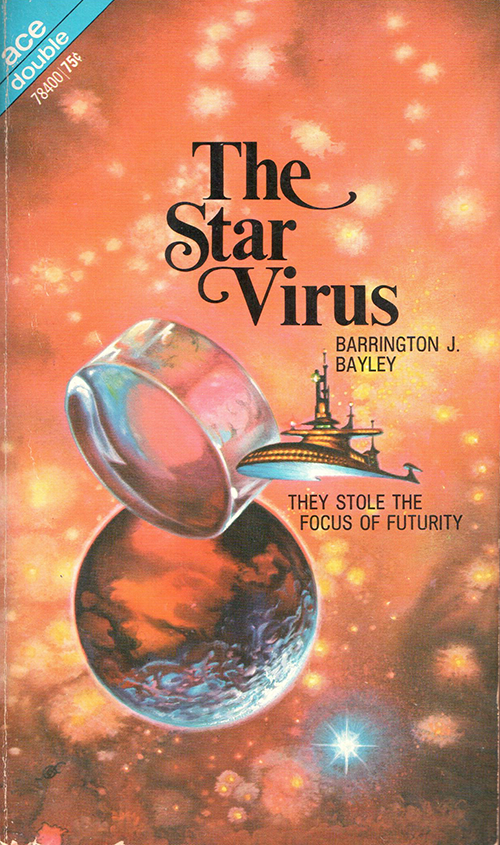I’m ambivalent about The Star Virus and the other two Barrington J Bayley books I’ve read, The Fall of Chronopolis and The Pillars of Eternity. I like how his protagonists are existentialist anti-heroes who get caught up in psychedelic space operas, but I dislike his characters’s nasty misogyny. I have similar reactions to Philip K Dick, but Dick’s psychedelia is so much more spectacular and he makes his protagonists’ troubles with and disdain for women seem so pathetic, so it’s palatable. Bayley is rough edged. His novels are abrasive and bleak but weird and stimulating. He was praised by Michael Moorcock, published short stories in the New Wave magazine New Worlds, and influenced M John Harrison’s space operas The Centauri Device and Light. This influence on one of the greatest contemporary SF authors is especially evident from The Star Virus, Bayley’s first novel.
Cover by Kelly Freas.
The Star Virus opens with the main character, a rogue named Rodrone, admiring the austere, violent landscape of an airless world. I prefer desert landscapes so I instantly grokked that and expected to sympathize with Rodrone but he quickly turns into an asshole, not caring about the loyalty or lives of his crew. In one scene that struck me as particularly hateful, he takes the evil emotional manipulation of a woman who plays a mind-altering musical instrument and extends her behavior to a stereotype of all overweight female musicians, whom he characterizes as craving and jealously hoarding the undeserved attentions of their audience. I can’t help but think that this is based on Bayley’s personal animosity towards someone, because he gives this villainess a normal-sounding name, Ruby, but all the other characters have otherworldly names like Kulthul, Redrace, and Clave Theory.
Mild spoilers and sexual assault trigger warning ahead.
However, by the end of The Star Virus, I thought it was a great, but nihilistic, space opera – as a sample of the bleakness, the titular virus is revealed to be humanity colonizing the galaxy. Rodrone is more invested in his intellectual pursuits than the lives of his friends or comrades and dismisses women almost completely. This is attributed in-text to his addiction to a drug that increases his ability to understand abstract concepts like advanced mathematics while it squashes his sex drive (a great SF concept), but besides the deluded villain Ruby and Rodrone’s unseen, unnamed wife, more of a symbol than a person, all the women in the book are “girls” who join in pirate orgies. I can handle an unsympathetic protagonist but this was written in 1970 – but Bayley couldn’t include one female space pirate? Rodrone’s most charitable act is holding himself back from rape – not exactly a gold standard, but about par for all Bayley’s characters.
In this future, humanity has spread throughout the Milky Way and Earth has been forgotten. Most people live in the Hub, the galactic core where there are so many close-packed bright suns that they shine through the daylight of most settled worlds. However, this is no cliched galactic empire – there is no central government at all. Instead, there are merchant houses, equivalent to interstellar corporations, that keep most people subjugated as serfs, and the free people who live like pirates, raiding merchant transport ships for stolen goods to fund their drug addictions, orgies, and technological innovations such as secret star drives and super weapons. This is a dark future of lawlessness and license, not the clean mirror-surfaced, sexless rocket ships and ray guns of someone like AE Van Vogt.
The Star Virus is a novel about human exceptionalism, where humans have some unique quality that makes them different from all the other aliens in the galaxy. Usually this trope annoys me, but in this case the self-aggrandizement is flipped because humans are especially deranged and dangerous, and there is an in-book explanation of why that doesn’t depend some galactic expansion of the imperialistic doctrine of manifest destiny. The idea that humans are different from all other intelligent beings is a heavy cudgel in the hands of most writers, but Bayley wields it like a scalpel, cutting it deftly and sewing it to the themes of his book. There’s also a strange artifact whose theft triggers the plot, but unlike most McGuffins, which could be exchanged for any other item that the characters fight over, the nature and effects of this ancient atomic lens, like Tolkien’s One Ring, is integral to the action and resolution of this story.
There are echoes of other stories too. A galactic barrier that was also in an original series Star Trek episode. Rodrone, like Elric in his debut short story, “The Dreaming City,” abandons a fleet of his allies to their doom. I took a break from The Star Virus to read a little Moorcock and I was struck by the parallels between Rodrone and Elric, two amoral-but-curious anti-heroes who leave a trail of dead friends wherever they go. At one point, Rodrone vainly stares at himself in the mirror and acknowledges that he is unusual, but can’t decide if he’s unusually weak or unusually strong. This same ambivalence is a central question in the Elric saga.
I’ve read a few articles about Bayley (like this one by Rhys Hughes and that one by another great SF writer Ian Watson) that wonder why he didn’t get greater acclaim for his novels. While I agree with these posts that his books are good, they’re very uncomfortable reads. His misogynistic characters are especially off putting to my sensibilities. But I’d rather read Bayley than Asimov, Niven, or other less daring SF writers. His experimentation, existentialism, and wild but wisely wielded ideas make his novels worthwhile.

